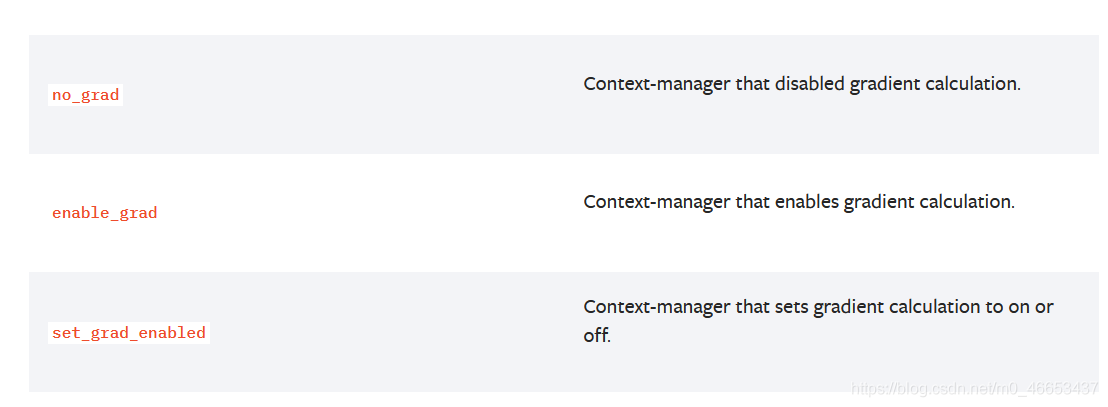torch.autogard.no_grad: 禁用梯度计算的上下文管理器。
当确定不会调用Tensor.backward()计算梯度时,设置禁止计算梯度会减少内存消耗。如果需要计算梯度设置Tensor.requires_grad=True
将不用计算梯度的变量放在with torch.no_grad()里
>>> x = torch.tensor([1.], requires_grad=True) >>> with torch.no_grad(): ... y = x * 2 >>> y.requires_grad Out[12]:False
使用装饰器 @torch.no_gard()修饰的函数,在调用时不允许计算梯度
>>> @torch.no_grad() ... def doubler(x): ... return x * 2 >>> z = doubler(x) >>> z.requires_grad Out[13]:False
torch.autogard.enable_grad :允许计算梯度的上下文管理器
在一个no_grad上下文中使能梯度计算。在no_grad外部此上下文管理器无影响.
使用with torch.enable_grad()允许计算梯度
>>> x = torch.tensor([1.], requires_grad=True) >>> with torch.no_grad(): ... with torch.enable_grad(): ... y = x * 2 >>> y.requires_grad Out[14]:True >>> y.backward() # 计算梯度 >>> x.grad Out[15]: tensor([2.])
在禁止计算梯度下调用被允许计算梯度的函数,结果可以计算梯度
>>> @torch.enable_grad() ... def doubler(x): ... return x * 2 >>> with torch.no_grad(): ... z = doubler(x) >>> z.requires_grad Out[16]:True
torch.autograd.set_grad_enable()
可以作为一个函数使用:
>>> x = torch.tensor([1.], requires_grad=True) >>> is_train = False >>> with torch.set_grad_enabled(is_train): ... y = x * 2 >>> y.requires_grad Out[17]:False >>> torch.set_grad_enabled(True) >>> y = x * 2 >>> y.requires_grad Out[18]:True >>> torch.set_grad_enabled(False) >>> y = x * 2 >>> y.requires_grad Out[19]:False
单独使用这三个函数时没有什么,但是若是嵌套,遵循就近原则。
x = torch.tensor([1.], requires_grad=True)
with torch.enable_grad():
torch.set_grad_enabled(False)
y = x * 2
print(y.requires_grad)
Out[20]: False
torch.set_grad_enabled(True)
with torch.no_grad():
z = x * 2
print(z.requires_grad)
Out[21]:False
补充:pytorch局部范围内禁用梯度计算,no_grad、enable_grad、set_grad_enabled使用举例


Locally disabling gradient computation 在局部区域内关闭(禁用)梯度的计算. The context managers torch.no_grad(), torch.enable_grad(), and torch.set_grad_enabled() are helpful for locally disabling and enabling gradient computation. See Locally disabling gradient computation for more details on their usage. These context managers are thread local, so they won't work if you send work to another thread using the threading module, etc. 上下文管理器torch.no_grad()、torch.enable_grad()和 torch.set_grad_enabled()可以用来在局部范围内启用或禁用梯度计算. 在Locally disabling gradient computation章节中详细介绍了 局部禁用梯度计算的使用方式.这些上下文管理器具有线程局部性, 因此,如果你使用threading模块来将工作负载发送到另一个线程, 这些上下文管理器将不会起作用. no_grad Context-manager that disabled gradient calculation. no_grad 用于禁用梯度计算的上下文管理器. enable_grad Context-manager that enables gradient calculation. enable_grad 用于启用梯度计算的上下文管理器. set_grad_enabled Context-manager that sets gradient calculation to on or off. set_grad_enabled 用于设置梯度计算打开或关闭状态的上下文管理器.
Microsoft Windows [版本 10.0.18363.1440]
(c) 2019 Microsoft Corporation。保留所有权利。
C:\Users\chenxuqi>conda activate pytorch_1.7.1_cu102
(pytorch_1.7.1_cu102) C:\Users\chenxuqi>python
Python 3.7.9 (default, Aug 31 2020, 17:10:11) [MSC v.1916 64 bit (AMD64)] :: Anaconda, Inc. on win32
Type "help", "copyright", "credits" or "license" for more information.
>>> import torch
>>> torch.manual_seed(seed=20200910)
torch._C.Generator object at 0x000001A2E55A8870>
>>> a = torch.randn(3,4,requires_grad=True)
>>> a
tensor([[ 0.2824, -0.3715, 0.9088, -1.7601],
[-0.1806, 2.0937, 1.0406, -1.7651],
[ 1.1216, 0.8440, 0.1783, 0.6859]], requires_grad=True)
>>> b = a * 2
>>> b
tensor([[ 0.5648, -0.7430, 1.8176, -3.5202],
[-0.3612, 4.1874, 2.0812, -3.5303],
[ 2.2433, 1.6879, 0.3567, 1.3718]], grad_fn=MulBackward0>)
>>> b.requires_grad
True
>>> b.grad
__main__:1: UserWarning: The .grad attribute of a Tensor that is not a leaf Tensor is being accessed. Its .grad attribute won't be populated during autograd.backward(). If you indeed want the gradient for a non-leaf Tensor, use .retain_grad() on the non-leaf Tensor. If you access the non-leaf Tensor by mistake, make sure you access the leaf Tensor instead. See github.com/pytorch/pytorch/pull/30531 for more informations.
>>> print(b.grad)
None
>>> a.requires_grad
True
>>> a.grad
>>> print(a.grad)
None
>>>
>>> with torch.no_grad():
... c = a * 2
...
>>> c
tensor([[ 0.5648, -0.7430, 1.8176, -3.5202],
[-0.3612, 4.1874, 2.0812, -3.5303],
[ 2.2433, 1.6879, 0.3567, 1.3718]])
>>> c.requires_grad
False
>>> print(c.grad)
None
>>> a.grad
>>>
>>> print(a.grad)
None
>>> c.sum()
tensor(6.1559)
>>>
>>> c.sum().backward()
Traceback (most recent call last):
File "stdin>", line 1, in module>
File "D:\Anaconda3\envs\pytorch_1.7.1_cu102\lib\site-packages\torch\tensor.py", line 221, in backward
torch.autograd.backward(self, gradient, retain_graph, create_graph)
File "D:\Anaconda3\envs\pytorch_1.7.1_cu102\lib\site-packages\torch\autograd\__init__.py", line 132, in backward
allow_unreachable=True) # allow_unreachable flag
RuntimeError: element 0 of tensors does not require grad and does not have a grad_fn
>>>
>>>
>>> b.sum()
tensor(6.1559, grad_fn=SumBackward0>)
>>> b.sum().backward()
>>>
>>>
>>> a.grad
tensor([[2., 2., 2., 2.],
[2., 2., 2., 2.],
[2., 2., 2., 2.]])
>>> a.requires_grad
True
>>>
>>>
Microsoft Windows [版本 10.0.18363.1440]
(c) 2019 Microsoft Corporation。保留所有权利。
C:\Users\chenxuqi>conda activate pytorch_1.7.1_cu102
(pytorch_1.7.1_cu102) C:\Users\chenxuqi>python
Python 3.7.9 (default, Aug 31 2020, 17:10:11) [MSC v.1916 64 bit (AMD64)] :: Anaconda, Inc. on win32
Type "help", "copyright", "credits" or "license" for more information.
>>> import torch
>>> torch.manual_seed(seed=20200910)
torch._C.Generator object at 0x000002109ABC8870>
>>>
>>> a = torch.randn(3,4,requires_grad=True)
>>> a
tensor([[ 0.2824, -0.3715, 0.9088, -1.7601],
[-0.1806, 2.0937, 1.0406, -1.7651],
[ 1.1216, 0.8440, 0.1783, 0.6859]], requires_grad=True)
>>> a.requires_grad
True
>>>
>>> with torch.set_grad_enabled(False):
... b = a * 2
...
>>> b
tensor([[ 0.5648, -0.7430, 1.8176, -3.5202],
[-0.3612, 4.1874, 2.0812, -3.5303],
[ 2.2433, 1.6879, 0.3567, 1.3718]])
>>> b.requires_grad
False
>>>
>>> with torch.set_grad_enabled(True):
... c = a * 3
...
>>> c
tensor([[ 0.8472, -1.1145, 2.7263, -5.2804],
[-0.5418, 6.2810, 3.1219, -5.2954],
[ 3.3649, 2.5319, 0.5350, 2.0576]], grad_fn=MulBackward0>)
>>> c.requires_grad
True
>>>
>>> d = a * 4
>>> d.requires_grad
True
>>>
>>> torch.set_grad_enabled(True) # this can also be used as a function
torch.autograd.grad_mode.set_grad_enabled object at 0x00000210983982C8>
>>>
>>> # 以函数调用的方式来使用
>>>
>>> e = a * 5
>>> e
tensor([[ 1.4119, -1.8574, 4.5439, -8.8006],
[-0.9030, 10.4684, 5.2031, -8.8257],
[ 5.6082, 4.2198, 0.8917, 3.4294]], grad_fn=MulBackward0>)
>>> e.requires_grad
True
>>>
>>> d
tensor([[ 1.1296, -1.4859, 3.6351, -7.0405],
[-0.7224, 8.3747, 4.1625, -7.0606],
[ 4.4866, 3.3759, 0.7133, 2.7435]], grad_fn=MulBackward0>)
>>>
>>> torch.set_grad_enabled(False) # 以函数调用的方式来使用
torch.autograd.grad_mode.set_grad_enabled object at 0x0000021098394C48>
>>>
>>> f = a * 6
>>> f
tensor([[ 1.6943, -2.2289, 5.4527, -10.5607],
[ -1.0836, 12.5621, 6.2437, -10.5908],
[ 6.7298, 5.0638, 1.0700, 4.1153]])
>>> f.requires_grad
False
>>>
>>>
>>>
以上为个人经验,希望能给大家一个参考,也希望大家多多支持脚本之家。如有错误或未考虑完全的地方,望不吝赐教。